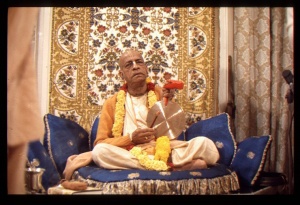CC Madhya 5.113

A.C. Bhaktivedanta Swami Prabhupada
TEXT 113
- tabe sei dui vipre kahila īśvara
- “tumi-dui—janme-janme āmāra kiṅkara
SYNONYMS
tabe — thereafter; sei — those; dui — two; vipre — unto the brāhmaṇas; kahila — spoke; īśvara — the Lord; tumi-dui — both of you; janme-janme — birth after birth; āmāra — My; kiṅkara — servants.
TRANSLATION
After the marriage ceremony was performed, the Lord informed both brāhmaṇas, “You two brāhmaṇas are My eternal servants, birth after birth.”
PURPORT
Like these two brāhmaṇas of Vidyānagara, there are many devotees who are eternal servants of the Lord. They are specifically known as nitya-siddha, eternally perfect. Although the nitya-siddhas appear in the material world and seem to be common members of the world, they never forget the Supreme Personality of Godhead in any condition. This is the symptom of a nitya-siddha.
There are two kinds of living entities—nitya-siddha and nitya-baddha. The nitya-siddha never forgets his relationship with the Supreme Personality, whereas the nitya-baddha is always conditioned, even before the creation. He always forgets his relationship with the Supreme Personality of Godhead. Here the Lord informs the two brāhmaṇas that they are His servants birth after birth. The phrase birth after birth refers to the material world because in the spiritual world there is no birth, death, old age or disease. By the order of the Supreme Personality of Godhead, the nitya-siddha remains within this material world like an ordinary man, but the only business of the nitya-siddha is to broadcast the glories of the Lord. This incident appears to be an ordinary story about a marriage transaction involving two ordinary people. However, Kṛṣṇa accepted the two brāhmaṇas as His eternal servants. Both brāhmaṇas took much trouble in these negotiations, just like mundane people, yet they were acting as eternal servants of the Lord. All nitya-siddhas within this material world may appear to toil like ordinary men, but they never forget their position as servants of the Lord.
Another point: The elderly brāhmaṇa belonged to an aristocratic family and was learned and wealthy. The young brāhmaṇa belonged to an ordinary family and was uneducated. But these mundane qualifications do not concern a nitya-siddha engaged in the service of the Lord. We have to accept the fact that the nitya-siddhas are completely distinct from the nitya-baddhas, who are ordinary human beings. Śrīla Narottama dāsa Ṭhākura confirms this statement:
- gaurāṅgera saṅgi-gaṇe, nitya-siddha kari’ māne,
- se yāya vrajendra-suta pāśa
- śrī-gauḍa-maṇḍala-bhūmi, yebā jāne cintāmaṇi
- tāra haya vraja-bhūme vāsa
One who accepts the associates of Lord Caitanya Mahāprabhu as nitya-siddhas is certain to be elevated to the spiritual kingdom to become an associate of the Supreme Lord. One should also know that Gauḍa-maṇḍala-bhūmi—those places in Bengal where Śrī Caitanya Mahāprabhu stayed—are equal to Vrajabhūmi, or Vṛndāvana. There is no difference between the inhabitants of Vṛndāvana and those of Gauḍa-maṇḍala-bhūmi, or Śrīdhāma Māyāpur.